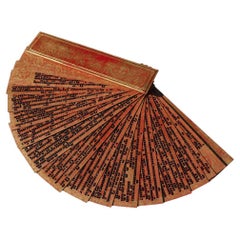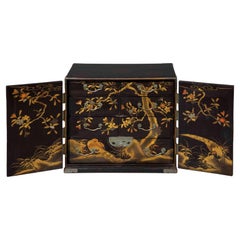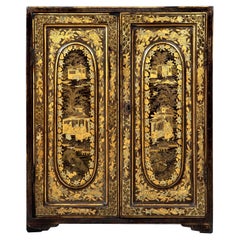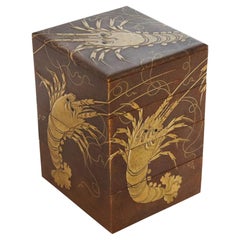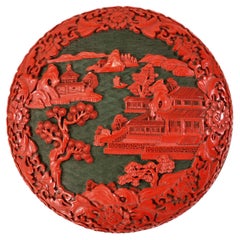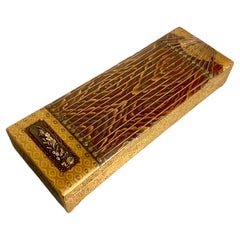Metal Lacquer
to
11
67
46
115
4
4
32
58
25
4
13
5
3
1
1
1
1
453
255
119
47
35
112
103
85
17
5
119
116
118
3
1
1
1
Material: Metal
Antique Burmese Gilt Lacquered Kammavaca Manuscript
Located in Point Richmond, CA
Antique Burmese Gilt Lacquered Kammavaca Manuscript, Consisting of 2 lacquered wood end covers and 16 double sided folios of lacquered cloth in red and black with gold leaf. This Kam...
Category
19th Century Burmese Other Antique Metal Lacquer
Materials
Gold Leaf
19th Century Japanese Lacquer Table Cabinet
Located in Richmond, London
A fine and rare Japanese black lacquer table or jewellery cabinet, exquisitely decorated in intricate detail, dating to the late Meiji per...
Category
Late 19th Century Japanese Meiji Antique Metal Lacquer
Materials
Metal
19th Century Chinoiserie Cabinet in Black Lacquer and Gilt Decoration
Located in Richmond, London
Exquisite early 19th century chinoiserie table cabinet in black lacquer and gilt decoration. Canton, circa 1830. Extremely rare to retain most of gilt decoration in such a pristine c...
Category
Early 19th Century Chinese Chinoiserie Antique Metal Lacquer
Materials
Gold Leaf
JAPAN Meiji Period 1870 Four Tiers Presentation Jubako Box Namiki Lacquer & Gold
Located in Miami, FL
Four Tier Japanese Gilt Jubako Maki-E box with red Interior.
This is a beautiful decorative presentation Jubako box created in the Imperial Japan during the early Meiji period (1868...
Category
1870s Japanese Meiji Antique Metal Lacquer
Materials
Gold
$4,360 Sale Price / set
20% Off
Large Domed Chinese Cinnabar Box
Located in Miami, FL
A large vintage Chinese red cinnabar box with deep relief carved lid depicting peonies, trees and a landscape with a palace. The round box has...
Category
1930s Chinese Chinese Export Vintage Metal Lacquer
Materials
Brass
Japanese Lacquer Writing Box, Suzuribako, Edo Period, 18th Century, Japan
Located in Austin, TX
An exceptionally fine and unusual Japanese lacquer writing implements box, suzuribako, in the form of a zither, koto, Edo Period, 18th century, Japan. With a modern wood storage box,...
Category
18th Century Japanese Edo Antique Metal Lacquer
Materials
Gold, Silver, Copper
Important Signed Vietnamese Lacquer
Located in Jersey City, NJ
This lacquer is decorated with deers in a lush environnement in lavish reds with a waterfall in silver leaf. It has a seal and is signed by the artist. Lacquer is an ancestral Viet...
Category
1950s Vietnamese Vintage Metal Lacquer
Materials
Gold Leaf
Antique Chinoisiere Lacquered Box
Located in New York, NY
Chinoiserie Lacquer Box. Beautifully hand painted Chinoiserie Box decorated with auspicious Chinese scenes. The box is constructed of wood having polychrome painting lacquered with...
Category
Early 20th Century Chinese Qing Metal Lacquer
Materials
Bronze
Portable jû'bako 重箱 (tiered food container)
Located in Amsterdam, NL
A rare, high quality lacquered portable jû'bako (tiered food container/stacked picnic box) fitted with a removable vertical safety bar - housing a nice secret – decorated with a refi...
Category
Late 19th Century Japanese Antique Metal Lacquer
Materials
Brass
Antique Korean Mother of Pearl Inlay Lacquer Tabletop Accessory Chest Joseon
Located in Atlanta, GA
An antique Korean lacquered small chest of drawers with Mother-of-Pearl inlays circa 19th century (late Joseon Dynasty). The tabletop box with multiple small drawers of various sizes...
Category
19th Century Korean Other Antique Metal Lacquer
Materials
Brass
Japanese Lacquer Incense Box, Kogo, Momoyama or Edo Period, 16th/17th Century
Located in Austin, TX
A wonderful Japanese lacquer incense box, kogo, with a design of plovers in flight, late Momoyama or early Edo Period, circa 1600, Japan.
The small box, called a kogo, was used to s...
Category
Early 17th Century Japanese Edo Antique Metal Lacquer
Materials
Gold, Pewter
Rare Antique Qing Dynasty Chinese Gilt Silver Filigree And Enamel Brise Fan
Located in Brea, CA
Rare Fine Antique early 19th century Chinese gilt silver filigree and enamel brise fan , Qing dynasty, the fan has 22 sticks with a 18k gold ring loop , wond...
Category
Early 19th Century Chinese Qing Antique Metal Lacquer
Materials
Silver, Enamel
Japanese inro box in black and gold lacquer with a decor of snowy landscape
Located in PARIS, FR
Inrō with four boxes in black and gold lacquer, representing a person in a pavilion in a snowy landscape with mountain on the background. Realised in maki-e on black lacquer with sma...
Category
Late 18th Century Japanese Edo Antique Metal Lacquer
Materials
Gold
Antique Chinese Cinnabar, Brass and Enamel Box
Located in Miami, FL
A crisply carved antique Chinese red cinnabar lacquer lidded round box with blue enamel interior and brass fittings. The "dragon's blood" trinket box has a fine peony, foliate and fl...
Category
19th Century Chinese Qing Antique Metal Lacquer
Materials
Brass, Enamel
17th Century Japanese Export Lacquer Cabinet with Depiction the Dutch Tradepost
Located in Amsterdam, NL
A highly important Japanese export lacquer cabinet with depiction of the Dutch East India Company tradepost Deshima and the annual Dutch delegation on its way to the Shogun in Edo
Edo period, circa 1660-1680
H. 88 x W. 100.5 x D. 54 cm
This cabinet includes a later European japanned stand, but also a modern powder-coated steel frame.
The latter can be designed and added to your specific needs.
The sides and front of the rectangular two-door cabinet are embellished in gold and silver hiramaki-e and takamaki-e on a black roiro lacquer ground with a continuous design. The two doors depict a long procession of numerous figures travelling on foot and horseback along buildings and a pagoda into a mountainous landscape. This is the annual court journey, Hofreis, of the Dutch from Nagasaki to the Shogun’s court in Edo. Three horseback riders are dressed as Dutch merchants and a fourth figure, probably het Opperhoofd, is seen inside a palanquin, norimon. Just about to cross the bridge, two men are carrying a cabinet like the present one.
Many Japanese figures on either side of the procession are engaged in various activities; some play musical instruments on board of small boats, others are fishing; figures inside buildings are depicted playing go, and farmers are tending to their rice paddocks. The upper part of the right door shows a large mansion, probably the local daimyo’s castle, with men kneeling before a man in the central courtyard.
The court journey fits in with the foreign policy of the shogunate which accorded a role to the VOC alongside China, Korea, and the Ryukyu Islands who also had to pay tribute. However, the VOC employees were traders, having low status in Japan’s social hierarchy, and they were received with less deference than were the state embassies from Korea and the Ryukyu Islands. Nevertheless, the contacts with the Dutch were a welcome source of information to the Shogun about Europe and European science and technology.
The left side of the cabinet depicts, in mirror image, a rare view of the artificial fan-shaped Deshima Island, the trading post for the Dutch in Japan. The island, where the Dutch flag flies, is surrounded by small Japanese boats and an anchored three-masted fluyt (cargo ship), flying Dutch flags, with on the stern the VOC monogram. On the bottom right a busy street of Nagasaki is shown, bordered by shops and leading up to the stone bridge. On the island the trees are beautifully painted, two cows can be seen, and the flagpole, all in very fine detail. Dutchmen and enslaved Malay are visible outside the buildings and two Japanese figures, probably guards, sit in a small hut in the centre.
A maximum of fifteen to twenty Dutchmen lived on the island at any time and soldiers or women were not allowed. Restrictions on Deshima were tight, and the merchants were only allowed to leave the island by special permission. The Opperhoofd had to be replaced every year, and each new Opperhoofd had to make a court journey to pay tribute, present gifts, and to obtain permission to Margaret Barclay eep on trading. In the distance, many birds fly above the hills and a four-story pagoda can be seen. The right side of the cabinet is painted with other horse riders and their retinue journeying through mountains.
The pair of doors to the front open to reveal ten rectangular drawers. The drawers are decorated with scenes of birds in flight and landscapes with trees and plants. The reverse of the left door with two thatched buildings, one with a ladder, underneath a camelia tree with large blooms; the right door with a three-story pagoda nestled among trees and both doors with a flying phoenix, ho-oo bird. The cabinet, with elaborately engraved gilt copper mounts, hinges, lock plates and brass handles, is raised on an 18th-century English japanned wood stand.
A pair of large cabinets...
Category
17th Century Japanese Edo Antique Metal Lacquer
Materials
Copper, Gold
Exquisite Japanese Lacquer Maki-e Suzuribako by Koma Kyūhaku Edo Period
Located in Atlanta, GA
One of the finest Japanese Maki-e Suzuribakos (ink box) we have on offer, the roiro color box showcases an ambient nocturnal scene in which two shakudo inlaid crows perched on the handrails of a bridge (possible the Uji Bridge...
Category
Early 19th Century Japanese Japonisme Antique Metal Lacquer
Materials
Stone, Metal
Rare Charming 17th Century Japanese Lacquer Cabinet with Gilt-Bronze Mounts
Located in Amsterdam, NL
A fine Japanese pictoral style lacquer cabinet with gilt-metal mounts
Kyoto, Edo period, 1670-1690
Decorated in Japanese relief lacquer work, black lacquer ground decorated...
Category
Late 17th Century Japanese Antique Metal Lacquer
Materials
Bronze
$44,930 Sale Price
25% Off
Vietnamese Lacquer By Pham Chinh Trung
Located in Jersey City, NJ
This a Lacquer on wood signed and dated in the lower left corner. Pham Chinh Trung was born in 1955 in Vietnam. He graduated from Hanoi university of industrial fine arts in 1979. Sp...
Category
20th Century Vietnamese Metal Lacquer
Materials
Gold Leaf
Japanese lacquer suzuri’bako 硯箱 (writing box) with shishi & Hotei design
Located in Amsterdam, NL
A captivating lacquer suzuri’bako (writing box) of rounded rectangular form depicting a pair of shishi (temple lions) and the lucky god Hotei 布袋 on a rôiro...
Category
Early 19th Century Japanese Antique Metal Lacquer
Materials
Gold Leaf, Silver Leaf
Japanese Tagasode (Whose Sleeves?) Lacquer Incense Box, Kobako, Meiji Period
Located in Austin, TX
A fine and unusual Japanese lacquer box for incense accessories, kobako, featuring a tagasode (whose sleeves?) design, Meiji Period, circa 1900, Japan.
The exquisite box of simple rectangular shape worked in maki-e lacquer, taka-maki-e, and raden, all against a lush ground of gold nashiji. Fitted with silver rims.
The main decorative element of the box depicts a six panel folding screen, byobu, showing an interior scene with kimono strewn over a rack, a motif known as tagasode (whose sleeves), all in raised taka-maki-e lacquer and inlaid raden.
The screen depicts an intimate room with tatami mats on the floor and sliding shoji doors in the background. The foreground depicts a large clothing...
Category
Early 1900s Japanese Meiji Antique Metal Lacquer
Materials
Silver
Pair of Fine Japanese Export Lacquer Cutlery Knife Boxes, 18th Century
Located in Amsterdam, NL
A pair of fine Japanese export lacquered cutlery boxes
Kyoto or Nagasaki, late 18th century
H. 33.5 x W. 24 x D. 21 cm
The bow-fronted boxes with sloping lids flat at the top are made of hinoki wood (Cypress), coated with Japanese paper and decorated in lacquer with scattered gold birds and flowers on a nashiji background. The Japanese mounts are made of copper and both boxes still have internal partitions to keep the cutlery upright.
The form of these boxes is similar to a pictorial-style knife box in the collection of the Groninger Museum (inv. 1989- 347), dated between 1730 and 1780, but the style of the decoration is more like that on a knife box in the Peabody Essex Museum in Salem (inv. E62271), which was brought to Salem by James Devereux, Captain of the Franklin, in 1799.
Provenance:
Henriette Jeane Christine van Neukirchen, called Nyvenheim (1807- 1849) and Nicolaas Johan Steengracht van Oostcapelle (1806-1866), thence by descent to the last owners, Ludolphine Emilie baronesse Schimmelpenninck van der Oye (1944) married in 1969 to Roland Daniel van Haersma Buma (1944), the last residents of castle Duivenvoorden near Voorschoten and the great-great-granddaughter of Nicolaas Johan Steengracht van Oostcapelle.
There is no evidence that Nicolaas Johan himself, or any of his or his wife’s ancestors had ever been in Japan. However, Nicolaas’ grandfather (Nicolaas Steengracht, 1754-1840) was a director of both the VOC and WIC (West Indies Company...
Category
Late 18th Century Japanese Antique Metal Lacquer
Materials
Silver
Japanese 19th Century Miniature Lacquer Chest with Waterfall
Located in Hudson, NY
Japanese 19th century miniature lacquer chest with waterfall. Late Edo to early Meiji period lacquer chest (mid to late 19th century) with two characters on the front reading Nuno an...
Category
Late 19th Century Japanese Antique Metal Lacquer
Materials
Gold, Silver, Bronze
Late 18th Century Indian Teak Dowry Box with Brass Mounts
Located in Middleburg, VA
A richly detailed Indian dowry box dating to the late 18th century, crafted during the final decades of the Mughal Empire. This pyramidal casket is construct...
Category
Late 18th Century Indian Agra Antique Metal Lacquer
Materials
Brass, Metal
Antique Japanese Edo Makie Lacquered Stand Hibachi Brazier Tea Fire Bowl Brass
Located in Dayton, OH
Antique Japanese late Edo / Tokugawa period Hibachi used for burning coal, as a portable heater, and as a heating device for a pot of tea. In modern times they work well as a planter...
Category
19th Century Japanese Edo Antique Metal Lacquer
Materials
Brass
$800 Sale Price
20% Off
A rare Japanese Namban export lacquer coffer with Mon emblems
Located in Amsterdam, NL
Late Momoyama period, late 16th century
The coffer is decorated in black lacquer, urushi, on cedar wood, decorated with gold dust and silver, maki-e, and nashiji, mother-of-pearl, r...
Category
16th Century Japanese Antique Metal Lacquer
Materials
Silver, Copper
Japanese Lacquer Hibachi with Imperial Chrysanthemum, Meiji Period, Japan
Located in Austin, TX
A simple and elegant Japanese lacquer hibachi stand with imperial chrysanthemum mon and copper liner, now modified as an usubata, late Meiji Period, ci...
Category
Early 1900s Antique Metal Lacquer
Materials
Copper
Japan 1810 Kajikawa Edo Period Five Drawer Inro Lacquered Gilt Wood With Rooster
Located in Miami, FL
Japanese Inro from the Edo period (1615-1868) created by Kajikawa.
Beautiful Inro, created in Japan by one of the Kajikawa family during the Edo period (1615-1868), circa 1810. Has been carefully crafted in carved precious wood with applications of gilding maki-e and decorated with Japonism patterns. All dan trays are attached together with a himo cord. The detailed craftsmanship was a true pleasure to behold.
Period: Edo period (1615-1868). Shogunate.
Approximate Date: 1790-1810
Motif: A family of birds consisting of a cockerel, the hen and three chicks.
Drawers: Five.
Shape: Rectangular navette.
Technique: Carved wood, lacquer and decorated in iroe-hiramaki-e on a gold ground.
Ojime: 15mm 20mm, oval carved from natural translucent agate.
Netsuke: None
Weight: 47.70 Grams.
Measurements: Inro is 78 mm by 55 mm by 18 mm (3.07 x 2.17 x 0.71 Inches).
Signatures: Kajikawa Saku, in the underside with the signature KAJIKAWA. By a member of the Kajikawa family, signed Kajikawa 梶川 Japan, late 18th century to early 19th century, Edo period (1615-1868).
The Kajikawa family
Kajikawa family, flourished in the 19th century, they was Japanese lacquerware artists whose school in Edo (now Tokyo) flourished for more than 200 years. This family is perhaps the most famous of all the dynasties of Japanese lacquer artists, and certainly the name most often found on inro. The family is said to have been founded by Hikobei at Edo in the early 17th century, although some claim that the family’s great reputation really stemmed from his son and pupil Kyujiro. In any event, Hikobei worked for the shogunate, as did his successors until well into the 19th century. Kijirō excelled in designing particularly delicate lacquer inrō, portable medicine cases...
Category
1810s Japanese Edo Antique Metal Lacquer
Materials
Agate, Gold
$3,560 Sale Price
20% Off
Japanese lacquer suzuri’bako 硯箱 (writing box) with ‘Rinpa School’-style design
Located in Amsterdam, NL
Superb rectangular ‘Rinpa School’-style black lacquer suzuri’bako (writing box) with a slightly arched well-fitted overhanging cover with rounded corners.
The lid with a design of a gosho’guruma (ox-drawn carriage for Heian-era nobles) featuring golden hiramaki-e (low-relief lacquer design) and takamaki-e (high-relief lacquer design), inlays of lead and shiny mother-of-pearl (raden). The design continues along the sides.
The reverse of the lid decorated with two large curving pine trees (matsu) executed in the same way, but also with intricate dots of tiny pieces of inlaid blue mother-of-pearl along the golden trunk.
The interior shaped to hold various scholar’s accessories, including a partially gold lacquered inkstone (suzuri) and a bronze waterdropper (suiteki) shaped like a mythical minogame.
The interior inscribed ‘Hokkyô Kôrin zô’ (Made by Hokkyô Kôrin). Referring to the design being in style of the master Ogata Kôrin, but the actual lacquer artist is unknown. It is a homage to Kôrin by an artist that followed the school of Rinpa.
Including black lacquer wooden tomobako (tomobako).
The Rinpa School was a key part of the Edo period revival of indigenous Japanese artistic interests described by the term yamato-e. Paintings, textiles, ceramics, and lacquerwares were decorated by Rinpa artists with vibrant colours applied in a highly decorative and patterned manner. Favoured themes, which often contained evocative references to nature and the seasons, were drawn from Japanese literature, notably The Tale of Genji, The Tales of Ise...
Category
19th Century Japanese Antique Metal Lacquer
Materials
Brass, Lead
Japanese landscape pine kobako box Edo period 18th century
Located in PARIS, FR
Rectangular black and gold lacquer kobako box decorated with pine trees in a mountain landscape in takamaki-e, kirigane and hiramaki-e lacquer. Background in nashi-ji lacquer. Surmou...
Category
18th Century Japanese Antique Metal Lacquer
Materials
Gold
Japanese Stacking Incense Box, Ju-Kobako, Meiji Period, Mid 19th century, Japan
Located in Austin, TX
An exquisite small Japanese maki-e lacquer stacking box for incense and accessories, ju-kobako, late Edo or early Meiji Period, mid 19th century, Japan.
Crafted in maki-e lacquer an...
Category
Mid-19th Century Japanese Meiji Antique Metal Lacquer
Materials
Silver
Japanese Edo Period Lacquer and Mother-of-Pearl Embellished Stoneware Koro
Located in Austin, TX
A highly unusual Japanese crackle glazed koro (incense burner or censer), lacquered and inlaid with mother-of-pearl embellishment, signed Gyokusen, Ed...
Category
19th Century Japanese Edo Antique Metal Lacquer
Materials
Copper
Chinese Cloisonne Mounted Red & Black Lacquer Box
Located in Atlanta, GA
This is a beautifully crafted lacquer box with a cloisonné enamel mount, featuring an intricate design that combines traditional craftsmanship with vibrant artistry. The lid showcase...
Category
20th Century Chinese Chinese Export Metal Lacquer
Materials
Enamel
$716 Sale Price
20% Off
Japan lake landscape kobako box lacquer - Edo
Located in PARIS, FR
Rectangular kobako box in takamaki-e and kirigane gold lacquer circled with pewter depicting a lake landscape. Inside and back of the box in nashi-ji lacquer.
Japan – Edo period (16...
Category
18th Century Japanese Antique Metal Lacquer
Materials
Gold
Japanese pair of kaioke boxes or Hokkaibako made of black and gold lacquer
Located in PARIS, FR
Two large eight-sided kaioke boxes in black lacquer, decorated with mon and maple leaves in golden lacquer.
These are usually octagonal boxes containing the painted shells used in ...
Category
Late 19th Century Japanese Meiji Antique Metal Lacquer
Materials
Gold
Japanese Lacquer and Gold Tray
Located in New Orleans, LA
This Meiji-period lacquer tray represents the mastery of Japanese craftsmen in the art of lacquer work. Precious materials are precisely inlaid in the lacquer base, creating a highly...
Category
Late 19th Century Asian Meiji Antique Metal Lacquer
Materials
Gold
Swedish Black Lacquered and Gilt Chinoiserie Tall Case Clock, Lanner, Circa 1775
By Josua Lanner
Located in Charleston, SC
Swedish black lacquered and gilt Chinoiserie tall case clock with arched decorative floral hood, flanking finials, turned bulbous columns, ormolu and steel engraved face, figural flo...
Category
1770s Swedish Gustavian Antique Metal Lacquer
Materials
Ormolu, Steel
Japanese Natsume or tea box adorned with mapple leaves and sakure flowers
Located in PARIS, FR
Natsume in dark red lacquer, decorated with autumn leaves and cherry blossoms in hiramaki-e and nashiji. Interior in black lacquer.
Maple leaves (Momiji) are celebrated in literature...
Category
Early 20th Century Japanese Taisho Metal Lacquer
Materials
Gold
19th Century Bronze White Rabbit Hand Warmer/Censer, Japan
Located in Point Richmond, CA
Handwarmer/Censer
Japan
circa 19th century
Bronze
Measures: H: 5.5 in x D: 8 in :: 14 cm x 20.3 cm
Happy Tibetan New Year of the Water Rabbit!
...
Category
19th Century Japanese Tribal Antique Metal Lacquer
Materials
Metal, Bronze
$800 Sale Price
20% Off
Chinese Red Lacquer & Brass Side Table Removable Ice Chest Style Hoof Foot Base
Located in Topeka, KS
Handsome Chinese red lacquer and brass ice chest, planter, accent table with galvanized insert and lid on hoof foot style removable base. This piece is in wonderful vintage condition...
Category
Mid-20th Century Chinese Chinoiserie Metal Lacquer
Materials
Brass
Japanese Lacquer Samurai Trunk From The Estate Of Sir John Richardson
Located in Essex, MA
With slightly domed removable lid opening to an open interior, conforming case with central gilded samurai family crest or Mon depicting a butterfly. Brass trim and handles. Richards...
Category
19th Century Japanese Meiji Antique Metal Lacquer
Materials
Brass
Pair of English Georgian Chinoiserie Red Lacquered Wall Mirrors
Located in Queens, NY
Pair of English Georgian (mid-18th Century) red lacquered and Chinoiserie decorated wall mirrors with gilt carved open pediment top with a centered cartouche. (PRICED AS Pair)
Lacqu...
Category
18th Century and Earlier English Georgian Antique Metal Lacquer
Materials
Gold Leaf
Early 20th Century Red Lacquered Chinese Trunk with Brass Hardware
Located in Winnetka, IL
A richly colored red lacquered Chinese storage trunk, dating to the early 20th century, featuring original brass hardware and hand-painted naturalistic decorations. The lid showcases...
Category
20th Century Chinese Chinese Export Metal Lacquer
Materials
Brass
Miniature hokkai bako or kaioke, doll furniture replica of a traditional box
Located in PARIS, FR
Small hokkai bako or kaioke seashells game box, of circular form with its four feet, its bronzes and cordon, decorated with a motive of flowers of gold lacquer on a black lacquer bac...
Category
Late 19th Century Japanese Meiji Antique Metal Lacquer
Materials
Gold, Bronze
Japanese Red Lacquer Negoro Hibachi with Rabbits, Edo Period, c. 1850
Located in Chicago, IL
With monumental scale and beautiful, hand-carved details, this remarkable red lacquer hibachi is a true work of art. Designed to hold glowing embers, hibachi vessels such as this were used for cooking or as a source of heat in Japanese homes. Placed under a low wood kotatsu table...
Category
Mid-19th Century Japanese Edo Antique Metal Lacquer
Materials
Metal, Bronze, Copper
Japanese Lacquer Incense Burner, Koro, Edo period, mid 19th century, Japan
Located in Austin, TX
An elegant and refined Japanese lacquer koro, incense burner, in the form of a chaire, tea caddy, Edo Perio, mid 19th century, Japan.
The barrel shaped koro formed as a traditional ...
Category
Mid-19th Century Japanese Edo Antique Metal Lacquer
Materials
Copper
Japanese Bundai or writting table in gold lacquer with a decor of lake landscape
Located in PARIS, FR
Rectangular bundai writing table on four legs in gold lacquer with black highlights on a nashi-ji background. The top is decorated with a lake landscape with plum trees, pine trees a...
Category
Early 18th Century Japanese Edo Antique Metal Lacquer
Materials
Gold, Bronze
Large Royal Early 17th Century Japanese Lacquer Chest with Gilt-Bronze Mounts
Located in Amsterdam, NL
A large Japanese transitional lacquer chest with gilt-metal mounts
Edo period, early 17th century
The rectangular chest with flat hinged lid decorated in gold, silver, and red ...
Category
Early 17th Century Japanese Antique Metal Lacquer
Materials
Bronze
Black Lacquer Box with Silver Birds by Hiroshi Mimura (1921–1975), Japan, Showa
Located in Fukuoka, JP
A striking and rare black lacquer box by celebrated Japanese lacquer artist Hiroshi Mimura (1921–1975), known for his bold, modernist reinterpretations of traditional techniques. Thi...
Category
20th Century Japanese Showa Metal Lacquer
Materials
Silver Leaf
An exceptional Namban 'escritório' writing-box, with a single drawer
Located in Amsterdam, NL
Kyoto, Late Momoyama to Edo period, circa 1590-1630
Decorated in pearl shell and gold with branches, leaves and flowers inside cartouches on a pearl shell mosaic background.
H. 25 ...
Category
17th Century Japanese Antique Metal Lacquer
Materials
Gold
Fine Japanese Export Red Lacquer Box with Masonic Symbols, circa 1800
Located in Amsterdam, NL
A fine Japanese export red lacquer box with Masonic symbols
Kyoto/Nagasaki, 1800-1820
Red lacquer decorated with scattered flowers and flying birds with long tails in gold, wit...
Category
Early 19th Century Japanese Edo Antique Metal Lacquer
Materials
Gold
Japanese Carved Cinnabar Lacquer Inro, Meiji Period, late 19th c, Japan
Located in Austin, TX
A good Japanese carved cinnabar three case inro with mixed metal ojime, Meiji period, late 19th century, Japan.
The three case inro of standard form, comprised of three container se...
Category
Late 19th Century Japanese Meiji Antique Metal Lacquer
Materials
Silver, Copper
Japanese Lacquer Kobako, Swallows and Bamboo, Edo Period, mid 19th c, Japan
Located in Austin, TX
A fine and elegant Japanese gilt maki-e lacquer box for incense accessories, kobako, late Edo period, mid 19th century, Japan.
The fantastic small box of rectangular form, with a sl...
Category
Mid-19th Century Japanese Edo Antique Metal Lacquer
Materials
Silver
Pair Japanese Lacquer Habachi
Located in Pasadena, CA
This is a beautiful example of the perfection of Japanese Minimalism design that dates to the Showa or possibly Taisho era. The simplicity of the circular form and minimal decoration...
Category
20th Century Japanese Showa Metal Lacquer
Materials
Copper
$1,400 Sale Price / set
20% Off
Persimmon Box in Black Lacquer by Robert Kuo, Limited Edition
By Robert Kuo
Located in Los Angeles, CA
Persimmon Box
Black Lacquer
Hand Repousse
Copper Base
Limited Edition
Lacquer is a laborious and time-consuming process. After it is tapped from the
trees, lacquer needs to b...
Category
21st Century and Contemporary Chinese Metal Lacquer
Materials
Copper
Japanese Taishō Period Early Red Lacquered Circular Hibachi, Early 20th Century
Located in Yonkers, NY
A Japanese Taisho period circular red lacquered hibachi from the early 20th century, with metal liner and lateral handles. Used for cooking or w...
Category
Early 20th Century Japanese Taisho Metal Lacquer
Materials
Metal
Set of 3 hibachi Incense burner Planters
Located in Fukuoka, JP
A rare and elegant set of three Japanese hibachi (traditional fire bowls) from the Meiji period (1868–1912), made of richly grained paulownia wood and intricately decorated with carv...
Category
20th Century Japanese Metal Lacquer
Materials
Belgian Black Marble, Copper
$2,890 / set
Japanese Export Nagasaki Lacquer Box with the Portrait of Napoleon Bonaparte
Located in Amsterdam, NL
A Japanese export Nagasaki lacquer tobacco box with the portrait of Napoleon Bonaparte
Edo-period, circa 1810
The box in black lacquer on copper, ...
Category
19th Century Japanese Edo Antique Metal Lacquer
Materials
Copper, Gold
Japanese Tebako in Nashiji lacquer adorned with golden Persimon flowers
Located in PARIS, FR
Tebako box with two compartments in golden and nashi-ji lacquer, decorated with golden, red, and kirigane lacquer, golden persimmon tree leaves, among rocks. The compartments are of ...
Category
Early 19th Century Japanese Meiji Antique Metal Lacquer
Materials
Gold
Japanese Red and Black Lacquer Maki-e Decorated Presentation Tray, dated 1917
Located in Austin, TX
A fine Japanese red and black maki-e lacquer presentation tray with original tomobako storage box, Taisho period, dated 1917, Japan.
The large prese...
Category
1910s Japanese Taisho Vintage Metal Lacquer
Materials
Gold
Japanese Samurai Abumi Stirrups Lacquer Edo, 18th Century
Located in Dallas, TX
Japanese Samurai Abumi Stirrups lacquer Edo late 18th century, early 19th century.
Measures: 12 inch length, 10 inch height, 5.5 inch width.
AVANTIQUES is dedicated to providing an...
Category
Late 18th Century Japanese Edo Antique Metal Lacquer
Materials
Iron
Recently Viewed
View AllMore Ways To Browse
Large Japanese Lacquer Box
Meiji Japan Tray
Lacquered Japanese Bowl
Japanese Comb
Japanese Lacquered Miniature
Japanese Red Lacquer Tray
Japanese Lacquer Plaque
Large Cinnabar
Chinese Carved Cinnabar Red Lacquer
Korean Mother Of Pearl Furniture
Korean Mother Of Pearl
Japanese Lacquer Ware
Antique Chinese Cinnabar Lacquer
Japanese Lacquered Trunk
Chinese Red Lacquer Tray
Red Lacquer Ware
Burmese Lacquer Trays
Japanese Makie Lacquer
